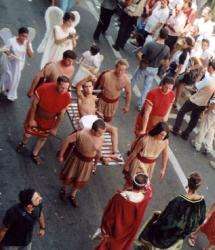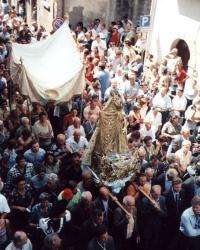Guardia Sanframondi
| Guardia Sanframondi | |
|---|---|
| Comune | |
| Comune di Guardia Sanframondi | |
.jpg) | |
 Guardia Sanframondi Location of Guardia Sanframondi in Italy | |
| Coordinates: 41°15′N 14°36′E / 41.250°N 14.600°ECoordinates: 41°15′N 14°36′E / 41.250°N 14.600°E | |
| Country | Italy |
| Region | Campania |
| Province | Benevento (BN) |
| Frazioni | Santa Lucia, Sapenzie |
| Government | |
| • Mayor | Floriano Panza |
| Area | |
| • Total | 21.1 km2 (8.1 sq mi) |
| Elevation | 428 m (1,404 ft) |
| Population (31 August 2017) | |
| • Total | 4,958 |
| • Density | 230/km2 (610/sq mi) |
| Demonym(s) | Guardiesi |
| Time zone | UTC+1 (CET) |
| • Summer (DST) | UTC+2 (CEST) |
| Postal code | 82034 |
| Dialing code | 0824 |
| Patron saint | St. Philip Neri |
| Saint day | 26 May |
| Website | Official website |
Guardia Sanframondi is a town and comune in the Province of Benevento, Campania region, Italy. It is best known for the penitential rite held every seven years.
Geography
The town is dominated by a medieval castle. Most of the historical center is accessible only by foot along narrow, stone, stepped streets and walkways. Much of the old town was vacated, as many locals prefer the new homes and shops that ring the old town, because they are accessible by automobile.
Below the town is one of the largest cooperative wineries in Europe; it produces both Guardiolo and Sannio wines with Falanghina and Aglianico as the primary grapes. The area is also a major olive producing region.
Penitential rite
Guardia hosts a riti settennali di penitenza or penitential rite every seven years. The rite honors the discovery of a Madonna and Child statue found in a field hundreds of years ago. The rite consists of a series of processions the week following the Assumption. Until recently, the rite was only known locally, but as residents moved elsewhere in Italy and abroad, word of the rite has spread. It has become something of a homecoming event. There are four components of the rite:

Mysteries
The four quarters of town each form committees to organize a parade of "mysteries" (religious scenes), with volunteers in period costumes from the Old Testament, New Testament, and Lives of Saints. The neighboring towns of San Lorenzo Maggiore and San Lupo join with the committees to stage a few of the mysteries. In 2003 there were about one hundred mysteries in all. During the week each quarter of town has a separate procession through its own neighborhood. On Sunday all the quarters form a grand procession. The participants hold a pose depicting a particular moment of the mystery as they walk through town—they do not act out events. The committees informally compete with each other to put on the finest mysteries.
Choirs
Each quarter also forms a choir that joins the processions. Traditionally the choirs were formed of unmarried girls, but recently married women, and occasionally men, have joined in. The women wear white clothing, a symbolic crowns of thorns, and braided cords around their shoulders.

Penitents
During the neighborhood processions, several flagellanti ("flagellants") join in. They gently strike their backs with a metal scourge. On Sunday, the procession is joined by several hundred battenti ("beaters") who strike their chests with a spugna (literally "sponge," it is really a disk of cork holding dozens of pins). Designated helpers pour white wine on the sponges during the procession, supposedly to ward off infection. There are a few dozen flagellanti during the Sunday procession, who also provide crowd control. The flagellanti and battenti are anonymous. They wear white hoods and are not even supposed to tell family members they are participating. Scourges and sponges are not carried openly or displayed in homes after the rite. The battenti are all men, although a few of the flagellanti are women.
Additionally there are a few dozen symbolic child flagellanti. They wear black robes and caps, and very gently swing a small scourge over their shoulders.

Statue
The rite ends with the procession of the Madonna and Child statue through the town. After the mysteries start, the statue is removed from the church, at which point a cannon sounds to announce the event. The procession stops and everyone kneels for a minute. When the statue makes its way to the town center, the battenti walk in front of it on their knees. When the procession continues, the crowds follow the statue, or walk backwards in front of it. The procession ends as the statue is returned to the church. All-night vigils in the Church of the Ave Gratia Plena continue for several days.